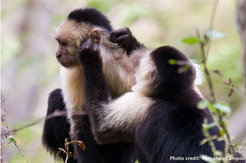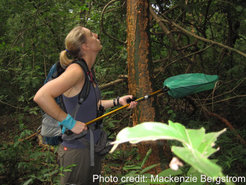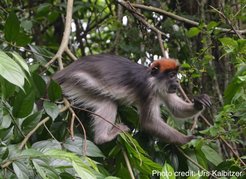
Why do friends matter?
Capuchins and red colobus monkeys are very different in their ecology and sociability. Here, we can compare how variability in sociability influences fitness parameters such as infant survival. What can we learn from these socially very different species regarding benefits and cost of different structures in human societies?
Social relationships are essential in humans and can be highly beneficial and supportive for our everyday life. Not only humans, but many animals live in social groups in which they form highly differentiated relationships with other individuals, ranging from weak to strong. Just as in humans, in social groups of non-human primates, some individuals are socially well integrated whereas others are more peripheral. In collaboration with scientists from the University of Calgary and the George Washington University, our research team is studying the potential benefits and costs of this variability in sociability. Using behavioral observations, endocrinological assessments, and life-history data in combination with state-of-the-art data analytical techniques, they aim to find out if and how female sociability is linked to fitness. A comparative approach between capuchin and red colobus monkeys, two primate species with differences in social behavior and ecology, will help us to gain a better understanding of the evolution of social behavior in primates, including humans.

Grooming capuchin females
Researchers have documented that in humans, social integration and support is positively correlated to health and longevity, as well as to greater reproductive success. Similarly, in many mammals, including dolphins, horses, and baboons, highly social females show better fitness parameters, such as improved offspring survival or longevity, than socially less integrated individuals.
In Santa Rosa, Costa Rica, we have the unique opportunity to study capuchin sociability in collaboration with Prof. Dr. Linda Fedigan, using an available long-term data set. She established the study site in 1983 – which makes it one of the longest continually running primate research sites worldwide. Capuchin monkeys are in many ways very similar to humans. They have a slow life history, highly invest in very few offspring, have an extended juvenile phase, rely on social learning and culture, and cultivate strong enduring relationships. This makes them a great study system to investigate sociability and to gain insights that will help us to better understand the link between fitness and sociability in humans.
What are the potential benefits of sociability?
In a previous study, we were able to show a link between infant survival probability and maternal social connectedness. During stable periods, infants of well-connected mothers were more likely to survive. However, this effect was reversed after alpha male replacements. Male infanticide is very frequent during such periods in white-faced capuchins. Presumably, it is beneficial for a new alpha male when females are proceptive rapidly, as it allows the male to spread his genes earlier.
Surprisingly, during such periods, offspring of less social females exhibited a higher survival probability than offspring of highly social females. Potentially, targeting particularly the infants of highly social females ensures higher survival chances of the new alpha male’s future offspring. Thus, we provided evidence that social integration can, at times, be negatively associated with offspring survival, and might therefore represent a trade-off in species with male infanticide.
So why do we observe a positive link between maternal social connectedness and infant survival during stable periods?
Female capuchins with strong social relationships may be more likely to receive coalitionary support during agonistic encounters with other group members. Such a link has been shown in another population of white-faced capuchins. If it exists in our study animals as well, such support may provide mothers with an advantage raising their infants.

Non-invasive urine sampling is time consuming but not impossible! One of multiple methods that allows us to investigate the nutritional condition is waiting for the monkey to urinate and then ‘catching’ the urine with a dip net-like device with a plastic bag.
Socially well-connected females may have also better access to food resources, which represents another potential mechanism linking fitness of females and their offspring to sociability. We investigate if and how sociability is associated with urinal c-peptide levels in capuchins, which serve as a good indicator of the energetic condition of individuals.
Infants might further benefit from maternal sociability by a term coined allo-parenting: being carried by other adults and even being allo-nursed by other females, which is generally rare in mammals but common in white-faced capuchins. We conduct social network analysis in combination with an analysis of the patterns of allo-parenting to reveal whether allo-parenting behavior represents a mechanism for the fitness-sociability link in capuchins. If so, infants of well-connected mothers would receive such services more often, and would therefore be more likely to survive.
Another potential benefit of sociability is being spatially central. Socially well-connected females and their offspring are found in the center of the group which may make them less vulnerable to predators. However, this may also explain the costs of maternal social connectedness during alpha male replacement periods, when infants of highly social and spatially central females are at greater risk of dying or disappearing compared to infants of less social females.
Does variability in sociability have fitness consequences in ‘less social’ monkeys?
Most research on fitness consequences of sociability in primates has focused on species with female philopatry (i.e., where females remain in their natal groups), and where these natal females commonly exchange affiliative behaviors with each other. Much less is known about group-living species who do not behave so.

To close this gap, we are currently extending our research on fitness benefits of social connectedness to red colobus monkeys in Kibale National Park, Uganda, in collaboration with Prof. Dr. Colin Chapman. In red colobus monkeys, females disperse to other groups and rarely show affiliative behaviors, thus they appear to have a very different social system from capuchins. In addition, red colobus and capuchin monkeys differ with regard to their diet. Whereas capuchins mainly feed on fruits and insects, red colobus are folivores and primarily feed on leaves. By common consent feeding on leaves - an abundant and relatively evenly distributed resource compared to fruit – affects how individuals compete over food resources with each other. As a consequence, red colobus show much less aggressive behavior against their conspecifics than many frugivorous or omnivorous primates.
We first examined whether females form differentiated social relationships at all, which they often but not always do. Next, we will study how social relationships change depending on distribution, availability, and nutritional quality of food resources. Subsequently, we aim to detect possible fitness consequences of variability in female social relationships in the ‘less social’ red colobus. We will study how this variability in sociability and food resources affects offspring survival. For this investigation, we are building on more than a decade of demographic data from red colobus in Kibale and collecting additional data on feeding and social behavior within an ecologically well-assessed habitat. Eventually, this research will provide us a deeper insight into the causes and consequences of different social structures.
Further reading & Cited articles
Social determinants of health and survival in humans and other animals
Female sociality and sexual conflict shape offspring survival in a Neotropical primate
Social relationships and physiological determinants of longevity across the human life span
Hunter-Gatherer Social Networks and Reproductive Success
Non-invasive estimation of the costs of feeding competition in a neotropical primate
Reciprocity and Rotating Social Advantage among Females in Egalitarian Primate Societies
Non-invasive estimation of the costs of feeding competition in a neotropical primate
Being friendly puts monkeys at risk in times of revolution
White-Faced Capuchin Monkeys Use Both Rank and Relationship Quality to Recruit Allies
Allonursing in white-faced capuchins provides evidence for cooperative care of infants
Want to learn more about capuchin monkeys?
Santa Rosa Primate Field Project
Resources
Data from Female sociality and sexual conflict shape offspring survival in a Neotropical primate (2018)
Written by Bianca Schell, Scientific Writer & Web Editor, Department for the Ecology of Animal Societies
Photos provided by Fernando A. Campos, Mackenzie Bergstrom & Urs Kalbitzer


